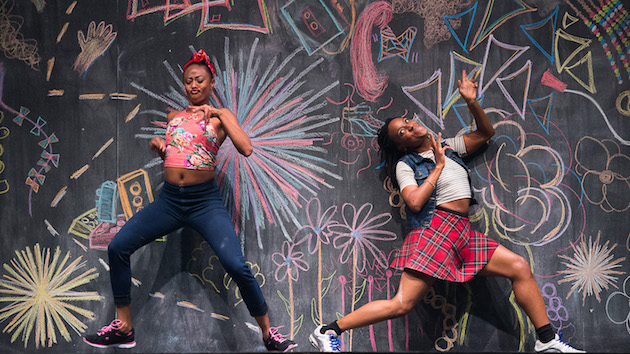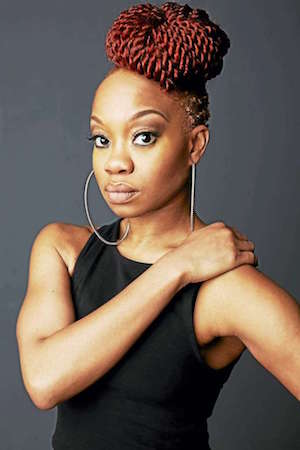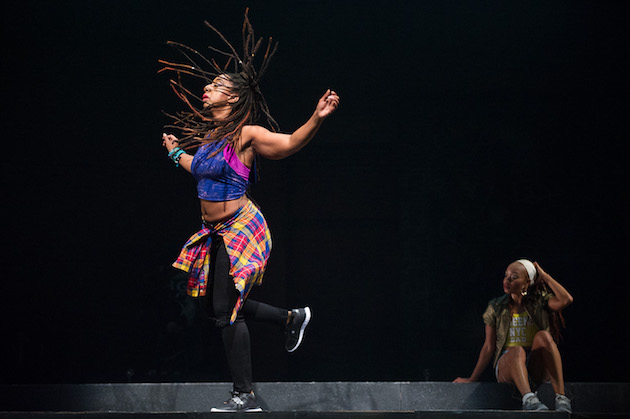
Simply because the obvious goes without saying doesn’t mean it shouldn’t be said. Or danced, sung, depicted in imagery or costumes, and made vibrant, visceral, and real in live performance instead of words.
Although, because the obvious can and sometimes demands to be spoken over and over again to appreciate its urgency, that is the approach taken by choreographer Camille A. Brown in a phone interview.
“Racism still exists, she says, stating the all too awful obvious. “When Obama was elected and people said this is a post-racist society, I knew I had to speak about it. With the election with Trump we’re looking at a time where this country is hurting. It’s a wound and we’ve just removed the Band-Aid. We’re seeing pain that’s been going on for hundreds of years. It’s a pain that’s not going away. I try to be aware of it, to create work to counter that. If other people have the audacity, I have to have the audacity too.”

Camille A. Brown & Dancers is preparing to present the Bay Area premiere of BLACK GIRL: Linguistic Play at Zellerbach Playhouse Dec. 8–10. But before that, there’s a little show at the Kennedy Center in Washington, D.C. The soon-to-be 38-year-old artistic director and her company will premiere ink, the last installation of the dance-theater trilogy that includes the Bessie-Award-winning Mr. TOL E. RAncE (2012) and 2015’s BLACK GIRL.
The Kennedy performances are the first time the two pieces that address history, contemporary culture, identity, and race will be performed on consecutive nights in one weekend. Brown anticipates discovering new truths and associations between the works. Where BLACK GIRL focuses on childhood games and play as the catalyst for black girls’ self-identity and interactions, ink investigates through ritual and gesture — with a score that includes blues, hip-hop, go-go, jazz, and swing — the power and freedom of the African-American experience that has been silenced or stifled throughout American history.
“ink and BLACK GIRL are about that black vernacular. It’s about how we can dig deeper into it,” says Brown. “These pieces are in conversation with each other. ink is speaking to BLACK GIRL.” Later she says, “The trilogy, one came from the other: they were born, one from another.” Vital to the work’s ancestry and future is making sure the work remains in connection to black lives as opposed to aiming for tolerance of black people and culture. “Tolerance is about stereotypes and wearing the masks: neither work is about that.”
Brown’s ideas expressed in an interview at first seem complicated, almost like she’s speaking in secret code. Especially in sentences rendered as rapidly as the dance phrases she concocts, her words hint at more than clarify the thicket of thought and complex, questioning process behind the work. Known to be a deep researcher and a greedy grabber of movement from ballet, jazz, tap, African, jazz, hip-hop, folk, and other dance forms, Brown also explores period specific music, literature, and history for each piece. Weaving or framing all of the elements with contemporary dialogue and context, the physical results are astonishingly straightforward: highly physical, polyrhythmic, intensely percussive, sinewy, fun-to-zany, virtuoso, urban, street, proscenium-stage savvy, fearless, unafraid of the dark, authentic.

“We definitely don’t do it the same,” Brown says, about performances of BLACK GIRL during the two years since its premiere. “Each time you step into a space, you’re a different person. We’re constantly changing and evolving. I want to bring all that new, individuality into the space. It’s each person telling their own story through that movement.”
Which means the steps and intentions don’t change, but each performance of BLACK GIRL is a unique expression. Creating the work altered Brown’s self-perception. The exploration of African-American childhood activities was vast: double Dutch and other sidewalk games, hand-clapping games, red light–green light, Marco Polo, West Indies ring shout rituals, clap-and-stomp juba dating back to slavery and plantation life, and more. Searching into spirit and spirituality, Brown found the little girl she used to be, but also heard the echo of stereotypes that label black girls as loud, ignorant, ghetto, angry. “The little girl was still inside me. All of these negative stereotypes that I see are dimensions I’ve always known, but they aren’t who I was. It’s nice to create a world where that is shown. I give myself the agency to create the type of work I want. It’s nice to reclaim who I am as a black girl and a black woman.”
Originally intending to make a 10-minute work, her vision broadened; inspired by play as source material and a book she read, Kyra Gaunt’s The Games Black Girls Play. “it’s amazing how play and wonderment could spark ideas I could expand. It became a 55-minute piece.” Performances are often followed by talkbacks or include outreach residency programs. In Berkeley as part of Cal Performances’ Berkeley RADICAL programming, the company conducts a public forum and a community dance class.
“This piece, even though the majority are white audiences, is for black girls,” Brown says. “But my hope is that no matter what, you see yourself in the work. This is culturally specific, but we’re talking about love, friendship, camaraderie—human themes. I’m hoping this challenges people to think with the (two part) title, that this is about something other than black girls. I’m hoping they think back to what they were thinking when they came (into the theater). I don’t want people to say, ‘This has nothing to do with me because I’m not a black girl.’” The work according to Brown honors black sisterhood and is a gift to black girls and black women — and to herself.
We close the interview talking about the role of artists in social justice advocacy and activism. Brown is articulate, educated, street smart, bold, female: Would the world with all its current pain be best served if she stepped from art into leadership in politics or the public service sector? “No, this is my most effective pulpit. Art has the ability to change laws, maybe not as directly as if I was a politician. It’s playing a role and this is mine. There’s been an urgency in every generation. This question of race is not a new topic. It’s something that is less about the artist and is more about outside people. The issue of black lives has been an issue since people were taken and brought to this country.”
Brown doesn’t know the next story she will tell. “I’m sure there’s another idea cooking, it just hasn’t shown itself yet. As we evolve, we’re creating those stories.” Until the next story is revealed, there is the trilogy: Mr. TOL E. RAncE, BLACK GIRL, and ink, in conversation.




